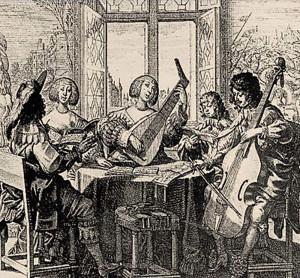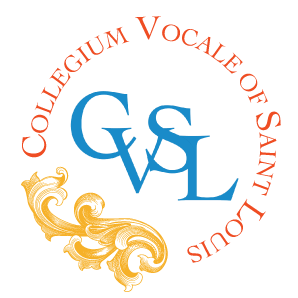Program Notes — Sunday, October 25, 2015

A staggering amount of music was composed during the eighteenth century. While much of what was written by Vivaldi, J. S. Bach, and G. F. Handel has been edited and issued in academic editions, other pieces by them and their contemporaries have continued to exist only in library-held manuscripts. The digital age has brought new life to some of this music as copies become available on the Internet. All of the music heard on today’s program has been transcribed and edited from these digital reproductions of the autograph and manuscript copies currently available on the Internet. The principal source for these works is the University and State Library in Darmstadt, Germany. The Landgrave of Hesse-Darmstadt, Ernst Ludwig (1667-1739), having aspirations of rivaling the cultural circumstances of Louis XIV of France at Versailles, hired some of the best musicians in Germany for his musical establishment and, as a side benefit, accumulated one of the most important music manuscript collections in Germany. However, these have not been heard since because the tendency of many musicologists is to focus on major figures of that time.
The cantata, “Posa d’un faggio all’ ombra,” was composed by Giovanni Alberto Ristori at the command of the Princess Anne Amalia, daughter of Frederick Augustus III of Saxony, and was sung by her to celebrate the Name Day of the King, her father. It probably was composed around 1735. Ristori was a noted Italian harpsichordist who spent most of his professional life working for the rulers of Saxony, who held court in Dresden and Warsaw. This work is unusual in that much of the harpsichord part is written out – chiefly preludes, postludes, and interludes – features that were customarily left for the keyboard player to improvise. This may have been done to accommodate the Princess, who was still a teenager and not a veteran singer. Ristori himself undoubtedly played the harpsichord part at the first Royal performance. The edition we are using today is drawn from the autograph copy held by the State and University Library in Dresden.
In 1709, Ernst Ludwig hired Christoph Graupner (1683-1760), a famous harpsichord player, away from the Hamburg Opera. Graupner then served as Director of Music at the Darmstadt court from 1711 until his death. Along with composing an enormous quantity of music that is just now being brought to wider attention, Graupner was responsible for organizing chamber music concerts every Sunday afternoon and on other occasions when requested by the Landgrave. It was also his responsibility to provide music for festive occasions, such as the Landgrave’s Name Day and Birthday. His cantata, “M’invita a la caccia,” was composed as a Prologue to a 1719 revival of the pastoral opera, “La constanza vince l’Inganno,” perhaps for such an occasion. The two arias we are performing today, are fully in the Italian style popular throughout Europe in the 18th century. The characters are drawn from Classical mythology and each aria is written in the da capo form that is in two sections, the first of which is repeated.
Johann Gottlieb Graun was one of the best violinists of his time in Germany. He was the brother of Karl Heinrich Graun (1704-1759), who was one of the premier opera composers in Germany, a contemporary of Handel and Hasse. J. G. Graun studied violin with J. G. Pisendl (1687-1775), who was the concertmaster of the famous orchestra in Dresden and who had studied violin with Giuseppe Tartini(1692-1770) in Italy. Graun’s cantata, “Ecco à voi, cari sassi,” heard on our program today, must have been held in some regard, for it exists in several manuscript copies from the 18th century, chiefly in libraries at Berlin, Dresden, and Darmstadt. The text was also set earlier in the 18th century both by Francesco Mancini, a Neapolitan composer, and by Emanuele, Baron d’Astora, another Italian composer. Graun’s cantata was probably composed sometime around 1750, based on its stylistic qualities, and was premiered in Dresden. Our performance edition is drawn from a copy held in the archives at Darmstadt.
The cantata by Antonio Caldara, “Non v’e pena ne l’amore,” was written and probably first performed in courts where Caldara was employed, either in Vienna or Dresden. It only survives only as a manuscript copy held in Darmstadt, upon which our edition is based. It was originally scored for voice, basso continuo, flute, and chalumeau, an early forerunner of the clarinet; however, it will be performed today with a violin playing the chalumeau part. Such substitutions were not uncommon during the 18th century. The chalumeau enjoyed its greatest popularity in Vienna and northern Germany, although Vivaldi also composed pieces for it. The form of this cantata is typical of the Italian cantata at this time: recitative, aria, recitative, aria.
The composer of Apollo in Tempe is uncertain and is probably not Giovanni Porta, as cited. However, one of only two manuscript copies of this work that exist, the one in Dresden, attributes this work to Porta, who was a Neapolitan composer working in Rome and Venice. It is clearly an Italian work. Its subject matter revolves around the arrival of the Greek God, Apollo, in the Valley of Tempe in Greece. Its intent is to flatter the cultural achievements and power of the Landgrave. Both surviving editions have been closely examined for this concert and interesting edits can be observed. The Darmstadt copy, the source of our edition, seems to have been reworked in the 18th century. A lengthy overture has been added; one of the characters has been rewritten from an alto to a high soprano and was given three new arias. Also the quartet has been extended by an extra 100 measures or so, a full third longer than its original length. In the opera of this period, any duet, trio, or quartet is very rare, especially one of this length. The most likely source of these revisions is Ernst Christian Hesse (1676-1762), a noted viola da gamba player hired by the Landgrave in 1698. Hesse served as Director of Music at court from 1707 to 1709. Trained as a lawyer, he also served as Secretary to the War Council for the Landgrave.
The Landgrave paid for Hesse to study in Paris and sent him to Italy for further study as well. Hesse’s second wife, Johanna Elisabeth Döbricht, a high soprano, was regarded as the best in Germany. While it was not unusual at that time to rewrite opera parts to suit a particular cast of singers, the fact that the part of Dorinda is the part that gains the most in opportunity for display in the revisions suggests that Hesse was looking out for his wife’s interests. One more interesting feature is that the words of the opening chorus are changed from, “Viva Apollo” to “Viva Ernesto.” There is a note in the Darmstadt archive that the work was performed as part of a celebration on the Landgrave’s Name Day, although which year is not mentioned. It may have been intended for 1724. A number of mysteries about this long-buried piece remain.
From manuscript to music…
There are two very interesting features found in the scores of today’s program. In the Graun cantata, the string parts for the opening accompanied recitative include vocal cues to help the ensemble stay more closely together. This is something often done in modern editions, but it is very rare to see it in original parts of this period. It is unknown whether this is a feature of Graun’s original composition or something added for the performance in Darmstadt. The pitches of the vocal part are notated on the upper staff in soprano clef.
Equally interesting is the written-out keyboard part for the Ristori cantata. As mentioned above, such matters were usually left to be improvised on the spot. Note that both the right hand of the keyboard part and the voice part are found on the upper staff of the score and that when the voice comes in, the keyboard has only a bass part over which he improvises the accompaniment. Additionally, the right hand part is notated in treble clef, while the voice part is in soprano clef.
© Dr. Bruce Carvell, Oct 2015




